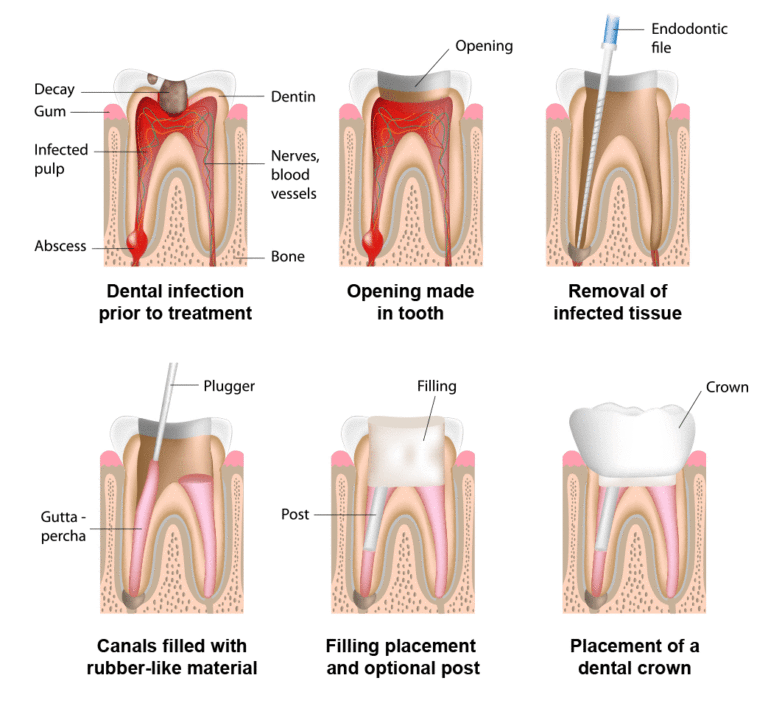Featured Endodontic Treatments at Khushi Dental Clinic
Khushi Dental Clinic,Mallapur-Nacharam road,Hyderabad aims to bust another myth about root canal treatments. Traditionally complete sterility of the root canal before the obturation process required the procedure to take place in multiple sittings. With refined and advanced cleaning techniques a single visit is enough to achieve the desired results that RCT aims to provide. Efficient and effective outcomes can be obtained with titanium instrumentations, reliable and accurate apex locators, microscopic and laser endodontics, digital radiography, biocompatible sealants and other advanced obturation systems.
A root canal therapy can last for several years. But there could come a point in the lifetime of the RCT that the tooth does not heal and can become diseased and painful. The occurrence of degradation can be in months or even years. The tooth may even develop new problems. Root canal failures are indicative of re-treatment. The presence of pain and swelling in most cases can be treated successfully with both methods non-surgical endodontic re-RCT and surgical endodontic re-RCT. A retreatment entails removal of the tooth, the fillings and elimination of infection after a thorough examination of the canals. The tooth is once again, cleaned and shaped and new, temporary fillings are placed. Once healed, the crown is fitted on the top to protect the tooth. Better concepts, advanced techniques, and high levels of education have improved the quality of restorations.
Fiber-optic lighting systems, headlamps for better visualization, ultrasonic devices to painlessly and noiselessly remove the old root canal and repairing it and better medicaments for disinfection and filling have made re-RCTs much easier.
Post and core procedures are done to anchor a crown or stabilize a weakened tooth. When tooth structure is inadequate to reinforce a conventional restoration then a small rod or post is inserted into the root space with a few millimeters of protrusion. This protrusion which is the core supports the large crown or filling, whichever is appropriate. The missing coronal tooth structure is replaced sufficiently to restore full functionality and aesthetics of the tooth.
Restorations performed to rehabilitate the decayed, fractured or cracked teeth located in the rear are called inlays and onlays. They are also known as indirect fillings and are sometimes used as conservative alternatives to full coverage dental crowns. Inlays and onlays are long-lasting reparative solutions that successfully re-establish aesthetics and functionality of the damaged tooth. They fit well, are strong and a widely chosen alternative to traditional fillings. Tooth decay and structural damage are repaired with inlays and onlays fabricated in a dental laboratory and then bonded to the damaged tooth.
In an inlay the material is bonded into the center of the tooth and in an onlay cusps may be included depending on the extent of damage and if full coverage of the biting surface is required.
Conservative dentistry in endodontics deals with the preservation of teeth. It is ideally a combination of operative dentistry and endodontics. The specialty encompasses restoration and preservation techniques of teeth and the diagnosis and treatment of dental caries to re-establish full functionality and aesthetics of the tooth.
Tooth decay is a common oral problem and most of the adults between the ages of 20 and 64 years suffer from tooth decay. The chewing surfaces of the teeth develop deep grooves called pits and fissures. They are found on the molars and premolars. The cavities in the molars are deeper than in the premolars. While chewing food may not be an issue food can still get stuck and form a bacterial film called plaque that accumulates if not cleaned regularly. A regular toothbrush may not be able to remove the food particles stuck in these areas. So the plaque stays in place and causes a cavity. A narrowed morphology provides the perfect space for the development of caries. Molars are the first set of permanent teeth and are the most susceptible set of teeth to occlusal caries.


